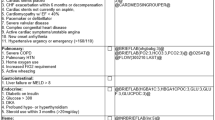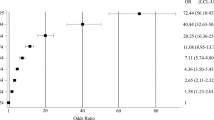Abstract
Purpose
Length of stay (LOS) is a major driver of cost and quality of care. A bundled payment system makes it essential for orthopaedic surgeons to understand factors that increase a patient’s LOS. Yet, minimal data regarding predictors of LOS currently exist. Using the ACS-NSQIP database, this is the first study to identify risk factors for increased LOS for orthopaedic trauma patients and create a personalized LOS calculator.
Methods
All orthopaedic trauma surgery between 2006 and 2013 were identified from the ACS-NSQIP database using CPT codes. Patient demographics, pre-operative comorbidities, anatomic location of injury, and post-operative in-hospital complications were collected. To control for individual patient comorbidities, a negative binomial regression model evaluated hospital LOS after surgery. Betas (β), were determined for each pre-operative patient characteristic. We selected significant predictors of LOS (p < 0.05) using backwards stepwise elimination.
Results
49,778 orthopaedic trauma patients were included in the analysis. Deep incisional surgical site infections and superficial surgical site infections were associated with the greatest percent change in predicted LOS (β = 1.2760 and 1.2473, respectively; p < 0.0001 for both). A post-operative LOS risk calculator was developed based on the formula: \( {\mathbf{e}}^{\left(\boldsymbol{intercept}+{\boldsymbol{\beta}}_1{\boldsymbol{X}}_1 + {\boldsymbol{\beta}}_2{\boldsymbol{X}}_2+\dots \right)} \).
Conclusions
Utilizing a large prospective cohort of orthopaedic trauma patients, we created the first personalized LOS calculator based on pre-operative comorbidities, post-operative complications and location of surgery. Future work may assess the use of this calculator and attempt to validate its utility as an accurate model. To improve the quality measures of hospitals, orthopaedists must employ such predictive tools to optimize care and better manage resources.

Similar content being viewed by others
References
Rana AJ, Bozic KJ (2015) Bundled payments in orthopaedics. Clin Orthop Relat Res 473(2):422–425. doi:10.1007/s11999-014-3520-2
Bel J-C, Carret J-P (2015) Total hip arthroplasty with minimal invasive surgery in elderly patients with neck of femur fractures: our institutional experience. Injury 46(Suppl 1):S13–S17. doi:10.1016/S0020-1383(15)70005-7
Castelli A, Daidone S, Jacobs R, Kasteridis P, Street AD (2015) The determinants of costs and length of stay for hip fracture patients. PLoS One 10(7):e0133545. doi:10.1371/journal.pone.0133545
Morshed S, Mikhail C, Miclau Iii T (2015) Timing of femoral shaft fracture fixation affects length of hospital stay in patients with multiple injuries. Open Orthop J 9:324–331. doi:10.2174/1874325001509010324
Sa-Ngasoongsong P, Kulachote N, Sirisreetreerux N et al (2015) Effect of early surgery in high surgical risk geriatric patients with femoral neck fracture and taking antiplatelet agents. World J Orthop 6(11):970–976. doi:10.5312/wjo.v6.i11.970
Sathiyakumar V, Shi H, Thakore RV et al (2015) Isolated sacral injuries: postoperative length of stay, complications, and readmission. World J Orthop 6(8):629–635. doi:10.5312/wjo.v6.i8.629
Freter S, Dunbar M, Koller K, MacKnight C, Rockwood K (2015) Risk of pre-and post-operative delirium and the delirium elderly at risk (DEAR) tool in hip fracture patients. Can Geriatr J 18(4):212–216. doi:10.5770/cgj.18.185
Licht H, Murray M, Vassaur J, Jupiter DC, Regner JL, Chaput CD (2015) The relationship of obesity to increasing health-care burden in the setting of orthopaedic polytrauma. J Bone Joint Surg Am 97(22):e73. doi:10.2106/JBJS.O.00046
Regan DK, Manoli A, Hutzler L, Konda SR, Egol KA (2015) Impact of diabetes mellitus on surgical quality measures after ankle fracture surgery: implications for “value-based” compensation and “pay for performance”. J Orthop Trauma 29(12):e483–e486. doi:10.1097/BOT.0000000000000394
Bohl DD, Ahn J, Rossi VJ, Tabaraee E, Grauer JN, Singh K (2016) Incidence and risk factors for pneumonia following anterior cervical decompression and fusion procedures: an ACS-NSQIP study. Spine J 16(3):335–342. doi:10.1016/j.spinee.2015.11.021
Bohl DD, Mayo BC, Massel DH et al (2015) Incidence and risk factors for pneumonia following posterior lumbar fusion procedures: an ACS-NSQIP study. Spine. doi:10.1097/BRS.0000000000001389
Lakomkin N, Greenberg SE, Obremskey WT, Sethi MK (2015) The risk of adverse events in orthopaedic trauma varies by anatomic region of surgery: an analysis of fifty thousand four hundred and twenty-one patients. Int Orthop 39(11):2153–2159. doi:10.1007/s00264-015-2899-z
Dodd AC, Lakomkin N, Sathiyakumar V, Obremskey WT, Sethi MK (2016) Do orthopaedic trauma patients develop higher rates of cardiac complications? An analysis of 56,000 patients. Eur J Trauma Emerg Surg. doi:10.1007/s00068-016-0649-6
Martin CT, Pugely AJ, Gao Y, Wolf BR (2013) Risk factors for thirty-day morbidity and mortality following knee arthroscopy: a review of 12,271 patients from the national surgical quality improvement program database. J Bone Joint Surg Am 95(14):e98,1-10. doi:10.2106/JBJS.L.01440
Molina CS, Thakore RV, Blumer A, Obremskey WT, Sethi MK (2015) Use of the national surgical quality improvement program in orthopaedic surgery. Clin Orthop Relat Res 473(5):1574–1581. doi:10.1007/s11999-014-3597-7
Sood A, Abdollah F, Sammon JD et al (2015) The effect of body mass index on perioperative outcomes after major surgery: results from the national surgical quality improvement program (ACS-NSQIP) 2005–2011. World J Surg 39(10):2376–2385. doi:10.1007/s00268-015-3112-7
Whiting PS, White-Dzuro GA, Avilucea FR et al (2016) Body mass index predicts perioperative complications following orthopaedic trauma surgery: an ACS-NSQIP analysis. Eur J Trauma Emerg Surg. doi:10.1007/s00068-016-0642-0
Sathiyakumar V, Thakore RV, Greenberg SE, Whiting PS, Molina CS, Obremskey WT, Sethi MK (2015) Adverse events in orthopaedics: is trauma more risky? an analysis of the NSQIP data. J Orthop Trauma 29(7):337–41. doi:10.1097/BOT.0000000000000293
Schoenfeld AJ, Serrano JA, Waterman BR, Bader JO, Belmont PJ Jr (2013) The impact of resident involvement on post-operative morbidity and mortality following orthopaedic procedures: a study of 43,343 cases. Arch Orthop Trauma Surg 133(11):1483–91. doi:10.1007/s00402-013-1841-3
Ireland AW, Kelly PJ, Cumming RG (2015) Total hospital stay for hip fracture: measuring the variations due to pre-fracture residence, rehabilitation, complications and comorbidities. BMC Health Serv Res. doi:10.1186/s12913-015-0697-3
Backes M, Schep NWL, Luitse JSK, Goslings JC, Schepers T (2015) The effect of postoperative wound infections on functional outcome following intra-articular calcaneal fractures. Arch Orthop Trauma Surg 135(8):1045–1052. doi:10.1007/s00402-015-2219-5
Thakore RV, Greenberg SE, Shi H et al (2015) Surgical site infection in orthopedic trauma: a case–control study evaluating risk factors and cost. J Clin Orthop Trauma 6(4):220–226. doi:10.1016/j.jcot.2015.04.004
Willey M, Karam M (2016) Impact of infection on fracture fixation. Orthop Clin N Am 47(2):357–364. doi:10.1016/j.ocl.2015.09.004
Brown CA, Olson S, Zura R (2013) Predictors of length of hospital stay in elderly hip fracture patients. J Surg Orthop Adv 22(2):160–163
Norris R, Parker M (2011) Diabetes mellitus and hip fracture: a study of 5966 cases. Injury 42(11):1313–1316. doi:10.1016/j.injury.2011.03.021
Author information
Authors and Affiliations
Corresponding author
Ethics declarations
Conflicts of interest
No benefits in any form have been received or will be received from a commercial party related directly or indirectly to the subject of this article.
Informed consent
Obtaining the informed consent from involved patients was waived by the Vanderbilt Institutional Review Board. All procedures involving human participants were in accordance with the 1964 Helsinki declaration and its later amendments. This study was approved by the Vanderbilt Institutional Review Board.
Appendix
Appendix
Rights and permissions
About this article
Cite this article
Chona, D., Lakomkin, N., Bulka, C. et al. Predicting the post-operative length of stay for the orthopaedic trauma patient. International Orthopaedics (SICOT) 41, 859–868 (2017). https://doi.org/10.1007/s00264-017-3425-2
Received:
Accepted:
Published:
Issue Date:
DOI: https://doi.org/10.1007/s00264-017-3425-2




